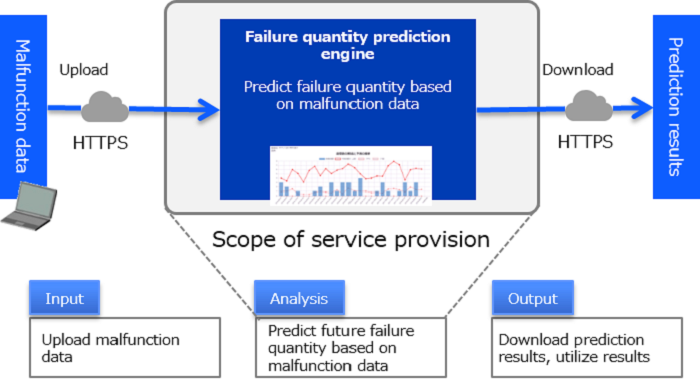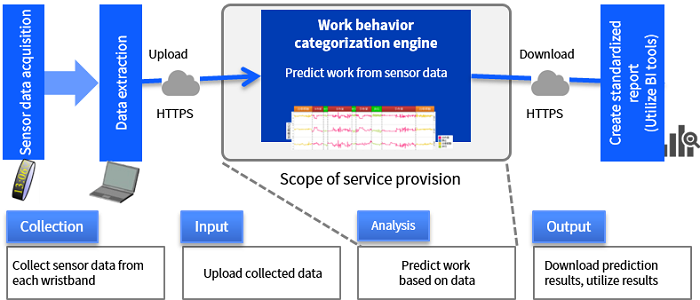News
Toshiba Launches "SATLYSKATA™”, an Easy-to-start High-grade AI Analytics Service That Transforms Businesses
- "Inventory Optimization of Maintenance Parts” and “Work Activity Estimation” cloud analytics services to be offered as first release -
November 21, 2018
Toshiba Digital Solutions Corporation
KAWASAKI, Japan―Toshiba Digital Solutions Corporation (TDSL) today announced that to offer its high-grade analytics AI, “SATLYS™”, to more customers, it will aggregate and standardize its AI analytics insights and commercially release “SATLYSKATA™”*1, an AI analytics service that is customized for specific purposes. As the first release, TDSL will offer two cloud analytics services, “SATLYSKATA™ Inventory Optimization of Maintenance Parts” and “SATLYSKATA™ Work Activity Estimation”, from today and expand its service lineup sequentially thereafter.
The Toshiba Group has many years of manufacturing insights and possesses world-renowned powerful AI technology*2 that has contributed to problem solving in various industry sectors thanks to its highly precise recognition, forecasting, cause prediction, anomaly detection, malfunction prediction and behavior prediction. In addition, Toshiba “SATLYS™” analytics AI helps solve customer issues and assists their digital transformation by covering a wide range of services including data analytics, system construction, managed services*3 and a “Professional Service”, which offers AI analysis for the industrial IoT sector.
The newly offered “SATLYSKATA™ Inventory Optimization of Maintenance Parts” is a service that optimizes component inventories by predicting appropriate procurement quantities based on component failure histories. In addition, “SATLYSKATA™ Work Activity Estimation” is a service that visualizes work activity by using wearable devices. These cloud analytics services are easy to use even for those without specialized AI knowledge: by simply inputting specified data, SATLYSKATA™ executes AI analytics and produces results (see Fig. 2 and Fig. 4).
TDSL will continue to improve the technical level of “SATLYS™” Toshiba analytics AI and expand application areas. TDSL will also improve the “SATLYSKATA™” AI analytics service lineup so it can solve the various issues of customers in industry and contribute to the acceleration of their digital transformation.
- * Details of “SATLYSKATA™ Inventory Optimization of Maintenance Parts” and “SATLYSKATA™ Work Activity Estimation” on p. 2 and 3.
Outline of “SATLYSKATA™ Inventory Optimization of Maintenance Parts”
~Optimizes component inventories by predicting appropriate procurement quantities based on component failure histories~
Companies that provide products and systems need to have a certain amount of maintenance components in inventory to prepare for sudden malfunctions or outages. On the other hand, excessive inventories of maintenance parts cause high costs due to storage or disposal.
“SATLYSKATA™ Inventory Optimization of Maintenance Parts” creates failure models using data on the failure histories for each maintenance component to manage inventories optimally. Even those without specialized AI knowledge can optimize their maintenance part inventories. As a result, costs related to excess maintenance component storage and disposal can be reduced and inventory assets can be shrunk while guaranteeing maintenance continuity. TDSL applied the service to maintenance component management for its own PC servers and confirmed a reduction of excess inventory by about 30%.

Figure 1: Outline image of “SATLYSKATA™ Maintenance Component Inventory Optimization”

Figure 2: Data input, analysis, result output for “SATLYSKATA™ Maintenance Component Inventory Optimization”
Related information:
- Survival Time Analysis Technology: Maintenance Parts Inventory Optimization (Toshiba Digital Solutions) (in Japanese)
https://www.global.toshiba/jp/company/digitalsolution/articles/sat/1801_2.html - Maintenance Parts Inventory Optimization and Maintenance Service Improvements Realized Simultaneously (DiGiTAL T-SOUL)
AI-based Failure Number Prediction System for PC Server Component
https://www.global.toshiba/ww/company/digitalsolution/articles/tsoul/24/004.html
Outline image of “SATLYSKATA™ Work Activity Estimation”
~Improves work effectiveness by visualizing work activity using wearable devices~
With the development of IoT technologies in recent years, it is becoming possible to monitor, predict and optimize the status of “things” in factory facilities, social infrastructure and other areas. On the other hand, there are next to no tools to monitor worker behavior at these sites.
“SATLYSKATA™ Work Activity Estimation” uses wristbands and other wearable devices to collect acceleration data from worker arm movements and uses deep learning technology to predict behavior of the wearer. Toshiba Logistics of the Toshiba Group used the service and confirmed an approximate 15% reduction in work times for order picking at its distribution warehouse by identifying issues, which was enabled by work visualization.

Figure 3: Outline image of “SATLYSKATA™ Work Movement Prediction”

Figure 4: Data collection, input, analysis, result output for “SATLYSKATA™ Work Behavior Prediction”
Related information
- Deep Learning Technology Work Behavior Prediction Using Wearable Devices (Toshiba Digital Solutions) (in Japanese)
https://www.global.toshiba/jp/company/digitalsolution/articles/sat/1710_2.html - Method for Work Analysis Using Human Activity Sensing Based on IoT Technology (Toshiba Review) (in Japanese)
https://www.global.toshiba/content/dam/toshiba/migration/corp/techReviewAssets/tech/review/2016/05/71_05pdf/f04.pdf - Applying Activity Measurement, Behavior of Warehouse Workers Analyzed (Toshiba IoT site) (in Japanese)
https://www.toshiba.co.jp/iot/usecase/logistics_002.htm - FY 2017 Logistics Grand Prize, Technology Application Award (Toshiba Logistics Corporation) (in Japanese)
https://www.toshiba.co.jp/logi/release/170904.html
About Toshiba “SATLYS™” Analytics AI
Toshiba “SATLYS™” analytics AI is a service that applies Toshiba’s 140 years of insights and achievements in manufacturing to AI design to realize high-precision recognition, forecasting, cause prediction, anomaly detection, malfunction prediction and behavior prediction. By offering solutions that use SATLYS to analyze inspection data, sensor data, work data and behavioral data, Toshiba is accelerating the digital transformation of its customers. For more information, please see the following website
https://www.toshiba-sol.co.jp/pro/satlys/
Notes:
- *1 SATLYSKATA:
Taking a cue from “kata”--or forms—found in karate and tea ceremony with their movements within a set range, the service was named as such to be a “kata” of SATLYS. - *2 Evaluated as a powerful AI technology by the world as follows:
・Received the Gold Award at the FY 2016 Japanese Society for Artificial Intelligence’s Field Innovation Award, which recognized Semiconductor Production Improvements at Yokkaichi City Factory
(June 2017 News Release from Toshiba Corporation and Toshiba Memory Corporation, in Japanese)
https://www.global.toshiba/jp/technology/corporate/rdc/rd/topics/17/1706-04.html
・Developed high-precision power demand prediction system that uses AI:
At the Tokyo Electric Power Company Holdings sponsored “1st TEPCO Electricity Load Forecasting Technology Contest”, among approximately 100 groups of applicants, Toshiba had the highest prediction accuracy and won the Grand Prize.
(November 8, 2017 News Release from Toshiba Corporation, in Japanese)
https://www.toshiba.co.jp/about/press/2017_11/pr_j0801.htm - *3 Managed service: an outsourced operation management service
- *SATLYS is a registered trademark or trademark of Toshiba Digital Solutions Corporation in Japan and other countries.
- *Other company names and product names in this document may be trademarks or registered trademarks of the respective companies.


